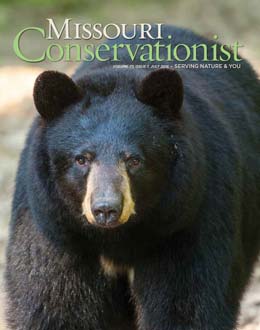What Is It?
Our photographers have been busy exploring the intricacies of outdoor Missouri. See if you can guess this month’s natural wonder.

Ask MDC
- Address: PO Box 180, Jefferson City, MO 65102-0180
- Phone: 573-522-4115, ext. 3848 Email: AskMDC@mdc.mo.gov
Q. I was on Table Rock Lake and noticed two geese nesting on a gravel bar where people like to hang out in the summer. I’m worried about these waterfowl. Can anything be done to protect them?
A. The geese were done nesting by mid-May. Once the eggs hatch, the adult pair will lead their goslings — sometimes several miles — to an open, often grassy area where other parent geese and goslings already have gathered. There the group will gather and form a “crèche,” a term that refers to a collection of fledglings.
Several species of waterfowl, including Canada geese, are known to form crèches. This phenomenon allows a few adults to watch over a much larger group of young — up to several hundred goslings — giving the adult geese more opportunity to forage.
If a predator does approach, noisy honking summons back the parents, who attempt to force the interloper to retreat by chasing, biting, and harassing it.
This tactic is sometimes, but not always, successful. Many goslings die naturally due to predation by foxes, dogs, coyotes, snapping turtles, large fish, and raptors. Although death is unpleasant to contemplate, predators are vital to the health and stability of the ecosystem.
Q. We live in an area abundant with coyotes. We hear them singing both during the day and at night. What are they communicating and why do they howl?
A. The scientific name for the coyote is Canis latrans, or barking dog, an apt name for this particularly vocal species. Employing a rich vocabulary, coyotes give various short sounds, such as barks, yips, growls, and whimpers.
Howling occurs at any time during the year, but more so during the mating period. These attention-getting sounds are heard most often from sunset to sunrise, but occasionally they are heard during the daytime, for example, before a storm.
Coyotes may bark alone or together. When one starts, often others take up the call until it becomes a chorus.
Although interpreting exactly what they are communicating involves some human speculation, researchers believe the animals are sharing information. When you hear a coyote call during the day, it might be communicating information about a fresh kill or complaining that another coyote is on its turf. It might be a mother in distress because her pup is missing or an amorous male chatting up a potential mate.
With practice and an educated ear, you may eventually be able to tell when a coyote is approaching its quarry and when it strikes.
Q. Why do wild turkeys wallow in the dust?
A. Many species of birds enjoy the act of dust bathing, which helps birds clean themselves and remove parasites. The powdery dust helps absorb oils that collect near the skin and in the feathers. After coating those oily spots with loose dust, larger particles form. The debris is easily shed from the bird’s feathers, removing the excess oil and dirt with it.

Agent Notes
Frogging in Missouri
Many of us have turned to fishing during the late hours of a hot summer day to beat the heat. At sunset on June 30, frogging season opens, bringing Missourians additional opportunities to experience the outdoors without the heat. Frogging is the sport of harvesting frogs at night with the aid of an artificial light using a multitude of tools, such as a gig, fishing pole, or by hand, just to name a few.
Two species of frogs, the bullfrog and green frog, are legal to harvest in Missouri. Both species are found almost anywhere shallow water is present, such as pond banks or the river’s edge.
There are both fishing and hunting methods used to harvest frogs. Each method provides varying levels of difficulty, making it the perfect sport for anyone from beginners to experts. A permit is required for frogging, and the method you choose will determine if you need a fishing permit or small game hunting permit. See the Wildlife Code for details.
Before summer is over, grab a flashlight and your preferred harvesting method and give frogging a try!
Tyler Mason is the conservation agent for Putnam County. If you would like to contact the agent for your county, phone your regional conservation office.
What Is It?
Eastern Prickly Pear
 Opuntia humifusa
Opuntia humifusa
The eastern prickly pear is a low spreading, succulent cactus. Its numerous yellow flowers with orange centers bloom from May through July. The large, paddle-like green pads are technically the thickened, flattened stems. New pads have tiny, soft, conical bumps that are the true leaves. These persist only briefly before drying and falling off. At the base of each leaf is a cluster of one to six spines plus many tiny, hair-like bristles that are very difficult to remove from the skin once they are embedded. Its fruit is edible, purplish red, and pear-shaped, with tufts or bristles. The seeds are embedded in a pale, slimy substance. The eastern prickly pear can be found nearly statewide, preferring to grow in sunny, dry places. Some of the plant’s typical habitats include upland prairies, sand prairies, glades, bluffs, rocky stream terraces, pastures, roadsides, and open, disturbed areas. —photograph by Jim Rathert
And More...
This Issue's Staff
Art Director - Cliff White
Associate Editor - Bonnie Chasteen
Staff Writer - Heather Feeler
Staff Writer - Kristie Hilgedick
Staff Writer - Joe Jerek
Photographer - Noppadol Paothong
Photographer - David Stonner
Designer - Les Fortenberry
Designer - Marci Porter
Designer - Stephanie Thurber
Circulation - Laura Scheuler






















